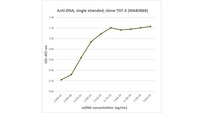New histone supply regulates replication fork speed and PCNA unloading.
Mejlvang, J; Feng, Y; Alabert, C; Neelsen, KJ; Jasencakova, Z; Zhao, X; Lees, M; Sandelin, A; Pasero, P; Lopes, M; Groth, A
The Journal of cell biology
204
29-43
2014
Kivonat megmutatása
Correct duplication of DNA sequence and its organization into chromatin is central to genome function and stability. However, it remains unclear how cells coordinate DNA synthesis with provision of new histones for chromatin assembly to ensure chromosomal stability. In this paper, we show that replication fork speed is dependent on new histone supply and efficient nucleosome assembly. Inhibition of canonical histone biosynthesis impaired replication fork progression and reduced nucleosome occupancy on newly synthesized DNA. Replication forks initially remained stable without activation of conventional checkpoints, although prolonged histone deficiency generated DNA damage. PCNA accumulated on newly synthesized DNA in cells lacking new histones, possibly to maintain opportunity for CAF-1 recruitment and nucleosome assembly. Consistent with this, in vitro and in vivo analysis showed that PCNA unloading is delayed in the absence of nucleosome assembly. We propose that coupling of fork speed and PCNA unloading to nucleosome assembly provides a simple mechanism to adjust DNA replication and maintain chromatin integrity during transient histone shortage. | 24379417
 |
Pharmacokinetic characteristics and biodistribution of radioiodinated chimeric TNT-1, -2, and -3 monoclonal antibodies after chemical modification with biotin.
Khawli, Leslie A, et al.
Cancer Biother. Radiopharm., 17: 359-70 (2002)
2002
Kivonat megmutatása
To improve the clinical potential of monoclonal antibodies (MAbs), new methods are required to augment antibody uptake in the tumor while minimizing binding in normal tissues. Our laboratory has pioneered the use of chemical modification to accomplish this goal. Using three chimeric MAbs, chTNT-1, chTNT-2, and chTNT-3, which target solid tumors by binding to common antigens found in the central necrotic core, we now demonstrate the potential of chemical modification to improve the pharmacokinetic characteristics of these unique MAbs. To identify optimal modification conditions, TNT MAbs were reacted with biotin at various ratios and tested by clearance and biodistribution analyses. The biodistribution results revealed that the numbers of biotin molecules per MAb yielding optimal tumor uptake were 3:1 for chTNT-1, 5:1 for chTNT-2, and 8:1 for chTNT-3. Biotinylated MAbs were found to have faster whole body clearance times and better biodistribution profiles compared to unmodified antibodies. Although chTNT-2 showed only a modest improvement after biotinylation, biodistribution results indicated that this MAb had the highest uptake in tumor. By reducing the charge of the antibody molecule, chemical modification appears to be a useful method for improving the pharmacokinetics and biodistribution of TNT antibodies directed to the necrotic region of solid tumors. | 12396700
 |
A new chemically modified chimeric TNT-3 monoclonal antibody directed against DNA for the radioimmunotherapy of solid tumors.
Hornick, J L, et al.
Cancer Biother. Radiopharm., 13: 255-68 (1998)
1998
Kivonat megmutatása
In the last several years, our laboratory has developed a new approach to the radioimmunotherapy of solid tumors, designated Tumor Necrosis Treatment (TNT), that exploits the presence of degenerating and necrotic cells within tumors by utilizing MAbs directed against universal, intracellular antigens. The first TNT MAb developed by our laboratory, designated TNT-1, was directed against nucleosomal determinants consisting of histone H1 and DNA. Since absolute tumor accretion of MAb is a critical determinant of antitumor efficacy in radioimmunotherapy, we sought to identify new antinuclear antibodies that displayed high tumor localization properties. In the present study, we describe a murine antinuclear antibody, TNT-3, which demonstrates 3-fold higher tumor uptake than TNT-1. Because of this characteristic, a chimeric derivative designated chTNT-3 was developed and evaluated for antigen binding and tumor targeting. ELISA studies using a series of nuclear antigens confirmed that TNT-3 is directed against single-stranded DNA and does not cross react with TNT-1. Immunohistology reveals predominantly nuclear staining reactivity in human tissues and tumors. Since it was shown by our laboratory that charge modification can significantly improve the pharmacokinetic performance of monoclonal antibodies, chTNT-3 was chemically modified with biotin to generate an improved therapeutic reagent designated chTNT-3/B. Comparative studies with unmodified MAb demonstrated that biotinylation significantly shortened its clearance time in mice and produced lower normal tissue levels, while maintaining an equal amount of uptake in tumor xenografts for up to 10 days. These in vivo characteristics suggest that chTNT-3/B is an improved TNT reagent for the radioimmunotherapy of solid tumors. | 10850361
 |











